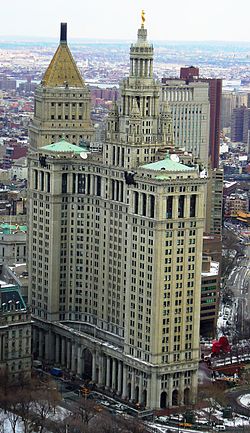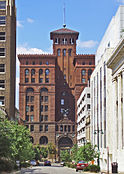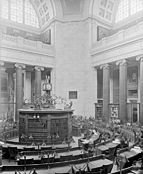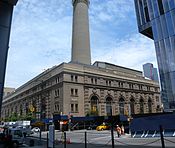- McKim, Mead & White
-
 Manhattan Municipal Building, built 1909-1915
Manhattan Municipal Building, built 1909-1915
McKim, Mead & White was a prominent American architectural firm at the turn of the twentieth century and in the history of American architecture. The firm's founding partners were Charles Follen McKim (1847–1909), William Rutherford Mead (1846–1928) and Stanford White (1853–1906). The firm was a major training ground for many other prominent architects -partners, associates, designers and draftsmen.
McKim and Mead joined forces in 1872 and were joined in 1879 by White who, like McKim, had worked for architect Henry Hobson Richardson. Their work applied the principles of Beaux-Arts architecture, the adoption of the classical Greek and Roman stylistic vocabulary as filtered through the Parisian Ecole des Beaux-Arts, and the related City Beautiful movement after 1893 or so, which aimed to clean up the visual confusion of American cities and imbue them with a sense of order and formality during America's Gilded Age.[1]
Mead was the last of the firm's founding partners to die in 1928, after McKim (1909), and White (1906).[2] The firm retained its name after the death of Mead, until partner James Kellum Smith's death in 1961. The firm – primarily Smith – designed the prominent National Museum of American History in Washington, D.C., one of the firm's last works, opening in 1964.[3] McKim, Mead & White was also involved with an urban renewal project at Pratt Institute in Brooklyn in the 1950s and designed three buildings as part of the project: DeKalb Hall, ISC Building and North Hall.[4][5]
In 1961, McKim, Mead & White was succeeded by the firm Steinman, Cain, and White, which by 1971 had become Walker O. Cain and Associates.[6][dead link]
Contents
Selected works
New York City
- Villard Houses, 451 Madison Avenue, Manhattan (1884).
- Harvard Club of New York, Manhattan (1894).
- 169 West 83rd Street, Manhattan, for David H. King, Romanesque revival(1885).
- Former New York Life Insurance Building, now 346 Broadway (1870) designed by Griffith Thomas, remodeled and expanded (1890s).[7]
- Madison Square Garden II at Madison Square, Manhattan, the second of four buildings known by this name (built in 1890, razed in 1925).
- Century Club, New York City (1891).
- The Cable Building, 611 Broadway, New York City (1892).
- West End Collegiate Church, West End Avenue, Manhattan (1892).
- Washington Arch, Washington Square Park, New York City (1892).
- Metropolitan Club, 1 East 60th St, NYC, New York (1893).
- Various features of Prospect Park, including Parade Place on Lookout Hill, the Peristyle, the Park Circle granite fixtures, Lullwater Bridge, and the 1895 Maryland Monument on Lookout Hill, Brooklyn, New York (1895-1900).
- Columbia University's Morningside Heights campus: general design and individual buildings including Low Memorial Library, Philosophy Hall, John Jay Hall, Avery Hall, Hamilton Hall (1893-1900).
- The University Heights campus of New York University (1891-1900), including the Hall of Fame for Great Americans (1900) (now the site of Bronx Community College), Bronx, New York.
- New York Herald Building (built in 1895, razed in 1921).
- Brooklyn Museum, Brooklyn, New York (1895)
- University Club of New York, New York City (1899)
- The Morgan Library & Museum, New York City (built in 1903, expanded in 1928).
- New York Public Library, between 1902 and 1914 designed 11 branches including: Hamilton Grange Branch (1905-1906) and 115th Street Branch (1907-1908)
- IRT Powerhouse, New York City (1904).
- Prison Ship Martyrs' Monument, Brooklyn, New York (1908).
- Knickerbocker Trust Building, 60 Broadway, Manhattan (built in 1909, later razed).
- The Manhattan Municipal Building, 1 Centre Street, Manhattan (1909–1915).
- Pennsylvania Station, Manhattan (1910, above-ground portion razed in 1963).
- 998 Fifth Avenue, Manhattan (1912).
- Bellevue Hospital Center, Manhattan (1912).
- James Farley Post Office (often regarded as the architectural twin of New York City's Pennsylvania Station) (1913).
- Racquet and Tennis Club, Manhattan (1916–1918)
- Hotel Pennsylvania, Manhattan (1919).
- The Town Hall, 123 West 43rd Street, Manhattan (1921).
- 110 Livingston Street, Brooklyn, New York, former Elks Lodge, and former headquarters of the New York City Department of Education (1926).
- Savoy-Plaza Hotel, Manhattan (built in 1927, razed in 1964).
- Liggett Hall, Governors Island, New York (1929).
New England and New York State
- Newport Casino, Newport, Rhode Island, 1880
- John Howard Whittemore House Naugatuck, Connecticut (1880s)[8]
- Isaac Bell House, Newport, Rhode Island, 1881–1883
- Cyrus McCormick summer estate, shingle-style Richfield Springs, New York, 1882; razed 1957
- Narragansett Pier Casino, Narragansett, Rhode Island, 1883
- Salem School, Naugatuck, Connecticut, 1884[8]
- Wolf's Head Society, "Old Hall", New Haven, CT, Yale University, 1884
- John F. Andrews Mansion, 32 Hereford Street, Boston, Massachusetts, 1886
- William G. Low House, Bristol, Rhode Island, 1887, razed 1962
- Algonquin Club, Boston, 1888
- Johnston Gate, Harvard University, Cambridge, Massachusetts, 1889
- Fayerweather Hall, Amherst College, Amherst, Massachusetts, 1890
- Walker Art Building, Bowdoin College, Brunswick, Maine, 1894
- Whittemore Memorial Library Naugatuck, Connecticut, 1894[8]
- Boston Public Library, Boston, 1895
- Dudley Pickman House, 303 Commonwealth Avenue (Bay Bay), Boston, 1895
- Reid Hall, Manhattanville College, Purchase, NY, 1895
- Rhode Island State House, Providence, Rhode Island, 1895–1904
- Garden City Hotel, Garden City, New York, 1895 (burned 1899)
- House for Frederick Vanderbilt, "Hyde Park", Hyde Park, 1895-1898
- Rosecliff, Newport, Rhode Island, 1898–1902
- Harbor Hill on Long Island, New York, built 1899-1902, razed 1947
- Hill-Stead Museum, estate of Alfred Atmore Pope, designed in collaboration with Theodate Pope Riddle, Farmington, Connecticut, 1901
- Astor Courts, estate of John Jacob Astor IV, built 1902-1904
- Faunce House (then Rockefeller Hall), Brown University, Providence, Rhode Island, 1904
- Naugatuck High School, Naugatuck, Connecticut, 1904 (Hillside Middle School since 1959)
- Plymouth Rock portico, Plymouth, Massachusetts, 1920
- Harvard Business School, 1925
- Olin Memorial Library, Wesleyan University, Middletown, Connecticut, 1925
- Memorial Chapel, Union College, Schenectady, New York, 1925
- Lincoln Alliance Building, Rochester, New York, 1926
- Levermore Hall, Blodgett Hall, and Woodruff Hall, Adelphi University, Garden City, New York, 1929
- Schenectady City Hall, Schenectady, New York, 1931–1933
- The Little Red Schoolhouse, Amherst College, Amherst, Massachusetts, 1937
New Jersey
- Orange Public Library, Orange, New Jersey, 1901
- Pennsylvania Station, Newark, New Jersey, 1935
- University Cottage Club Princeton University, Princeton, New Jersey, 1906
Washington, D.C.
- The West Wing and East Wing of the White House, 1600 Pennsylvania Avenue, Washington D.C., 1903 renovation
- Roosevelt Hall, National War College, Fort Lesley J. McNair, Washington, D.C., 1903–1907
- National Museum of American History, Washington, D.C., 1964
Other U.S. locations
- First Methodist Episcopal Church, Lovely Lane United Methodist Church, Baltimore, Maryland, 1884
- Omaha National Bank Building, Omaha, Nebraska (originally the New York Life Building), 1889[9]
- New York Life Insurance Building, Kansas City, Missouri, 1890
- Open Gates, George Sealy Mansion, Galveston, Texas, 1891
- The Agricultural Building at the World Columbian Exposition, Chicago, Illinois), 1893
- Old Cabell Hall, Cocke Hall, and Rouss Hall, University of Virginia, Charlottesville, circa 1898
- Savoyard Centre, Detroit, Michigan, 1900
- English Building, University of Illinois at Urbana-Champaign, Champaign, Illinois, 1905
- The Minneapolis Institute of Arts, Minneapolis, Minnesota, 1915
- National McKinley Birthplace Memorial Library and Museum, Niles, Ohio, 1915
- Butler Institute of American Art, Youngstown, Ohio, on National Register of Historic Places, 1919
- Cohen Memorial Hall (Vanderbilt Fine Arts Gallery), Vanderbilt University, Nashville, Tennessee, circa 1928
- Milwaukee County Courthouse, Milwaukee, Wisconsin, 1931
- Dietrich Hall, now Steinberg-Dietrich Hall, University of Pennsylvania, 1952
Other countries
- additions to the Bank of Montreal Head Office, Montreal, 1901–1905
- American Academy in Rome (Main Building), Rome, Italy, 1914
- Hotel Nacional de Cuba, Havana, Cuba, 1930
- Bank of Montreal Building, Winnipeg, Manitoba, 1913
Noted architects of McKim, Mead & White
- Lewis Colt Albro – later partnered briefly with Harrie T. Lindeberg for several commissions
- Henry Bacon – worked at the firm from about 1886 through 1897; left with fellow employee James Brite to open their own office
- William A. Boring – worked at the firm in 1890 before forming a separate partnership with Edward L. Tilton
- Charles Lewis Bowman – a draftsman at the firm until 1922, noted for his large number of private residences around Eastchester, New York
- Walker O. Cain – worked at the firm then took it over and renamed it several times, beginning in 1961
- John Merven Carrère (1858–1911) – of Carrère and Hastings worked together for McKim, Mead and White from 1883 through 1885, then partner with Thomas Hastings.
- J.E.R. Carpenter – worked at the firm for several years before becoming the designer of much of upper Fifth and Park Avenues, including 907 Fifth Avenue, 825 Fifth Avenue, 625 Park Avenue, 550 Park Avenue and the Lincoln Building on 42nd Street.
- Cass Gilbert – worked with the firm until 1882 when he went to work with James Knox Taylor; later designed many notable structures, among them the George Washington Bridge and the Woolworth Building.
- Arthur Loomis Harmon – later of Shreve, Lamb and Harmon worked at the firm.
- Thomas Hastings (1860–1929) – of Carrère and Hastings worked together for McKim, Mead and White from 1883 through 1885.
- Harrie T. Lindeberg – started at the firm in 1895 as an assistant to Stanford White and remained with the firm until White's death in 1906
- Edward Lippincott Tilton – assisted with the design of the Boston Public Library in 1890 before leaving with Boring
- James Kellum Smith – (1893-1961) a member of the firm from 1924 to 1961; full partner in 1929, and was the last surviving partner of MM&W. He primarily designed academic buildings, but his last major work was the National Museum of American History.
- Tracy and Swartwout – worked together as draftsmen for the firm.
- Robert von Ezdorf – took over much of the firm's business after White's death
- William M. Whidden – worked at the firm from at least 1882 until 1888; projects included the Tacoma and Portland Hotels; relocated to Portland, Oregon in 1888 to finish the hotel and established his own firm with Ion Lewis
- Joseph M. Wells – (1853-1890) worked as firm's 1st Chief Draftsman from 1879-90, the "4th partner", and was largely responsible for Renaissance designs in 1880s per MB Triumvirate - see below.
- York and Sawyer – worked together for the firm before starting their own partnership in 1898; Edward York (1863–1928) and Philip Sawyer (1868–1949).
Gallery
-
"Wolf's Head Old Hall," completed in 1884. Purchased by Yale University, 1924.
-
New York Life Insurance Building, Kansas City, Missouri,
built 1888-1890 -
Rotunda of Low Memorial Library, Columbia University, built 1895. Photo taken circa 1900-1910.
-
Naugatuck High School (1904). Image: c. 1910.
-
Pennsylvania Station, Manhattan, built 1905-1910
References
- Notes
- ^ Broderick, Mosette (2010), Triumvirate: McKim, Mead & White: Art, Architecture, Scandal, and Class in America's Gilded Age [Deckle Edge [Hardcover]], http://www.amazon.com/Triumvirate-Architecture-Scandal-Americas-Gilded/dp/0394536622
- ^ "[Mead's] widow receives all the estate of about $250,000" in New York Times (November 27, 1928); "Mrs. Olga Kilenyi Mead, widow,... bequeathed her entire estate to the trustees of Amherst College, Amherst, Mass." in New York Times (April 23, 1936). The money was used to build the Mead Art Building, which was designed by James Kellum Smith of McKim, Mead and White. The building was completed in 1949.
- ^ "NMAH Mission & History". National Museum of American History. Smithsonian Institution. http://americanhistory.si.edu/about/mission.cfm. Retrieved 2007-09-26.
- ^ "Pratt Institute: DeKalb Hall 1954-55". http://pratt.edu/~yyoon/dekalb.htm. Retrieved 2007-09-26.
- ^ Hilary Ballon & Kenneth T. Jackson. Robert Moses and the Modern City: The Transformation of New York. p. 374.
- ^ http://library.bowdoin.edu/arch/images/gallery/library/library.shtm
- ^ Norval White and Elliot Willensky, AIA Guide to New York City, rev. ed., (New York: Collier Books, 1978), p.40.
- ^ a b c Blackwell, D. and The Naugatuck Historical Society (1996) "Images of Naugatuck". Arcadia Publishing
- ^ Bluffton University Digital Imagine Project
- Bibliography
- Baker, Paul R. Stanny: The Gilded Life of Stanford White. New York: Free Press, 1989. ISBN 0029017815
- Broderick, Mosette. Triumvirate: McKim, Mead & White: Art, Architecture, Scandal, and Class in America's Gilded Age New York: Knopf, 2010. ISBN 0394536622
External links
- McKim, Mead and White flickr group
- Randall's Lost New York City Cable Building is included as a special resource.
- McKim, Mead & White in Buffalo
- McKim, Mead, and White
- McKim, Mead, and White
- FindaGrave site with photos of gravestone of William and Olga Mead in Rome, Italy
- FindaGrave site with photos of Joseph M. Wells and his gravestone in Mass.
Categories:- Architecture firms based in New York City
- Defunct architecture firms based in New York City
- McKim, Mead, and White buildings
- Architects from New York
- People from New York City by occupation
Wikimedia Foundation. 2010.








